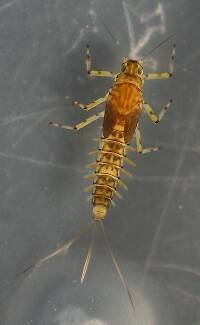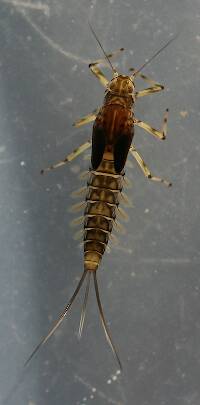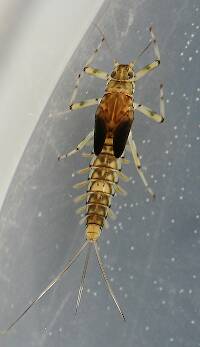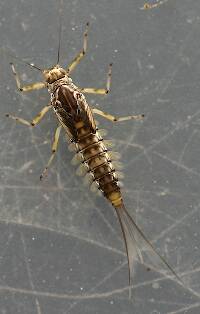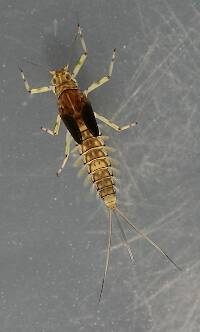
Salmonflies
Pteronarcys californica
The giant Salmonflies of the Western mountains are legendary for their proclivity to elicit consistent dry-fly action and ferocious strikes.
Featured on the forum

Troutnut is a project started in 2003 by salmonid ecologist Jason "Troutnut" Neuswanger to help anglers and
fly tyers unabashedly embrace the entomological side of the sport. Learn more about Troutnut or
support the project for an enhanced experience here.
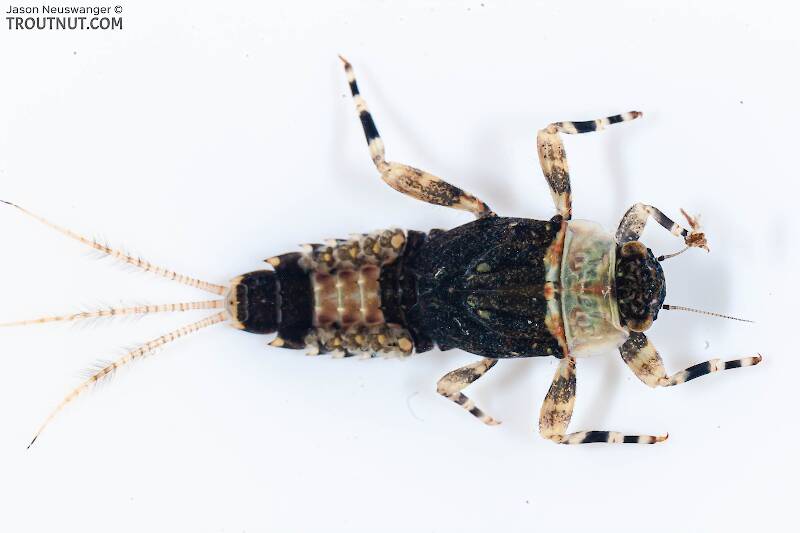
I've never seen this strange coloration on any Ephemerella subvaria nymph in a book before, but it's similar to several other specimens I collected on the same outing, including a smaller one that I photographed. They were outnumbered by the "normal" Ephemerella subvaria nymphs in the sample.
Martinlf on Dec 23, 2006December 23rd, 2006, 12:34 pm EST
This photo shows the light band on the top of the subvaria nymph. The lighter collar seems to be abnormal, or at least an unusual color variation, if I remember the previous discussion on this photo.
I just noted the photo of the bug's belly. It appears solid brown, much to my surprise. Hmm. . . Gonzo? I believe he's away for the holidays, but I'll be interested in his answer on imitating this and other nymphs.
I've navigated away from the photo of the subvaria's underwater on the rock, but they are awesome too.
I just noted the photo of the bug's belly. It appears solid brown, much to my surprise. Hmm. . . Gonzo? I believe he's away for the holidays, but I'll be interested in his answer on imitating this and other nymphs.
I've navigated away from the photo of the subvaria's underwater on the rock, but they are awesome too.
"He spread them a yard and a half. 'And every one that got away is this big.'"
--Fred Chappell
--Fred Chappell
GONZO on Dec 26, 2006December 26th, 2006, 12:55 pm EST
Louis,
Be careful to consider the collection dates and maturity of the nymphs before drawing final conclusions about coloration. At first, I was a little thrown by your observations and the pictures. I'm used to seeing a greater degree of countershading (dark backs and light bellies) on the mature nymphs I collect. I even commented elsewhere that the ventral coloration of fully mature subvaria nymphs can reflect the belly color of the dun. (I've collected dark brown female Hendrickson nymphs that had pink bellies.)
Unfortunately, I couldn't find any of the photos of subvaria or invaria nymphs that were within a week of their typical emergence dates. I think you'll find, however, that if you generally compare the mature nymphs (collected near emergence and with dark wingcases) of most mayfly species with their earlier instars, the mature nymphs usually display a greater degree of countershading. Most earlier instar nymphs spend their days in the gravel (sometimes quite deep in the substrate), and countershading would seem to be of most value in final instar nymphs and adults (especially duns). Local conditions (tannic waters, for example) may influence the degree of color variation, possibly including the degree of countershading.
While the light-colored pronotum pictured above is somewhat unusual (at least for subvaria nymphs), the light-colored "saddle" on the dorsal surface of the abdomen is common on several Ephemerella nymphs. I imitate it with a stroke of dark marker (black, brown, or grey--depending on the base dubbing shade) at the rear of the abdomen and just behind the wingcase, leaving the lighter patch in the middle.
Be careful to consider the collection dates and maturity of the nymphs before drawing final conclusions about coloration. At first, I was a little thrown by your observations and the pictures. I'm used to seeing a greater degree of countershading (dark backs and light bellies) on the mature nymphs I collect. I even commented elsewhere that the ventral coloration of fully mature subvaria nymphs can reflect the belly color of the dun. (I've collected dark brown female Hendrickson nymphs that had pink bellies.)
Unfortunately, I couldn't find any of the photos of subvaria or invaria nymphs that were within a week of their typical emergence dates. I think you'll find, however, that if you generally compare the mature nymphs (collected near emergence and with dark wingcases) of most mayfly species with their earlier instars, the mature nymphs usually display a greater degree of countershading. Most earlier instar nymphs spend their days in the gravel (sometimes quite deep in the substrate), and countershading would seem to be of most value in final instar nymphs and adults (especially duns). Local conditions (tannic waters, for example) may influence the degree of color variation, possibly including the degree of countershading.
While the light-colored pronotum pictured above is somewhat unusual (at least for subvaria nymphs), the light-colored "saddle" on the dorsal surface of the abdomen is common on several Ephemerella nymphs. I imitate it with a stroke of dark marker (black, brown, or grey--depending on the base dubbing shade) at the rear of the abdomen and just behind the wingcase, leaving the lighter patch in the middle.
Martinlf on Dec 27, 2006December 27th, 2006, 2:00 am EST
Thanks for correcting my misperception here. I had thought the ventral side should be lighter. The point about maturity is well taken, and this may be helpful to others as they look at photos here and elsewhere. I'm getting ready to tie up some nymphs (I just need to get some of the right color and size thread now) and this will help keep me on track.
"He spread them a yard and a half. 'And every one that got away is this big.'"
--Fred Chappell
--Fred Chappell
GONZO on Dec 27, 2006December 27th, 2006, 6:06 am EST
Your comments on the photos provided an interesting lesson for me as well. I generally don't pay that much attention to the earlier instar nymphs I find, except to note significant populations that I might want to intercept during their emergence later in the season. The appearance of immature mayfly nymphs can be so different from mature specimens that I usually don't use them as models for imitation. (I do imitate immature stonefly nymphs that have two- or three-year life cycles.)
When you are viewing photos of mayfly nymphs in sources that don't list the valuable collection dates that Jason provides, you can usually recognize specimens of earlier instars by their underdeveloped wingcases. (Early stages also appear more translucent with a darkened central core.) More mature nymphs have more fully formed wingpads, and nymphs with darkened wingpad tips are usually within a day or so of hatching. (You can usually gauge the progress of a current hatch by the percentage of dark wingpads in the population. I have also noticed that male Ephemerellidae seem to mature/hatch earlier in the hatching cycle than the females.)
As a side note about seine samples, it's worth mentioning that early season samples don't always yield a complete picture of the immature nymphs that will comprise later hatches. Some of this is attributable to immature nymphs living deep in the substrate (where this is possible), and sometimes early instars utilize different habitat than mature nymphs.
When you are viewing photos of mayfly nymphs in sources that don't list the valuable collection dates that Jason provides, you can usually recognize specimens of earlier instars by their underdeveloped wingcases. (Early stages also appear more translucent with a darkened central core.) More mature nymphs have more fully formed wingpads, and nymphs with darkened wingpad tips are usually within a day or so of hatching. (You can usually gauge the progress of a current hatch by the percentage of dark wingpads in the population. I have also noticed that male Ephemerellidae seem to mature/hatch earlier in the hatching cycle than the females.)
As a side note about seine samples, it's worth mentioning that early season samples don't always yield a complete picture of the immature nymphs that will comprise later hatches. Some of this is attributable to immature nymphs living deep in the substrate (where this is possible), and sometimes early instars utilize different habitat than mature nymphs.
Quick Reply
Related Discussions
Topic
Replies
Last Reply
1
May 5, 2009
by GONZO
by GONZO
7
Sep 18, 2006
by Troutnut
by Troutnut




